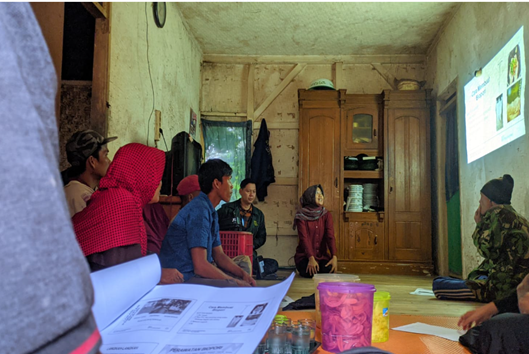Pemberdayaan Masyarakat Desa Puspahiang Kabupaten Tasikmalaya Melalui Penerapan Teknologi Biopori dalam Pemupukan Community Empowerment at Puspahiang District Tasikmalaya Village by Application of Biopori Technology during Fertilization
Main Article Content
Abstract
The limited knowledge of farmers in cultivating mangosteen causes the quality of the trees to decrease—the decreasing number of production evidence this. So there is a need for efforts to increase mangosteen production with good cultivation or farming techniques. So this service activity is to conduct fertilization training with the bio-pore technique, which can reduce yellow sap contamination and provide calcium according to the tree's needs. This service's stages include counseling and socialization of bio-pore fertilization, land measurements, and satisfaction surveys. In addition, measurements of soil nutrients with acidity levels were carried out to help farmers deal with fruitless trees. As a result of the bio-pore installation activity, 80% of the farmers can understand and will apply the bio-pore technique to the farmers' mangosteen fields.
Downloads
Article Details

This work is licensed under a Creative Commons Attribution-ShareAlike 4.0 International License.
Authors who publish with this journal agree to the following terms:
- Any article on the copyright is retained by the author(s).
- Author grant the journal, right of first publication with the work simultaneously licensed under a Creative Commons Attribution License that allows others to share work with acknowledgment of the work authors and initial publications in this journal.
- Authors are able to enter into a separate, additional contractual arrangements for non-exclusive distribution of published articles of work (eg, post-institutional repository) or publish it in a book, with acknowledgment of its initial publication in this journal.
- Authors are permitted and encouraged to post their work online (e.g., in institutional repositories or on their websites) prior to and during the submission process, as can lead to productive exchanges, as well as earlier and greater citation of published work.
- The article and any associated published material is distributed under the Creative Commons Attribution-ShareAlike 4.0 International License
References
Anantanyu, S. (2011). Kelembagaan Petani: Peran dan Strategi Pengembangan Kapasitasnya. SEPA: Jurnal Sosial Ekonomi Pertanian dan Agribisnis, 7(2), 102-109. https://doi.org/10.20961/sepa.v7i2.48895
Fathurrohman, M. I., Erinasari, F. D., Hawa, U. M., & Farisa, D. T. (2023). Inovasi Lubang Resapan Biopori Menggunakan Pipa Paralon sebagai Upaya Mengurangi Penumpukan Sampah Organik di Desa Margasari. Jurnal Pusat Inovasi Masyarakat, 5(1), 61-67. https://doi.org/10.29244/jpim.5.1.61-67
Ichsan, I., & Hulalata, Z. S. (2018). Analisa Penerapan Resapan Biopori Pada Kawasan Rawan Banjir Di Kecamatan Telaga Biru. Gorontalo Journal of Infrastructure and Science Engineering, 1(1), 33-46. https://doi.org/10.32662/gojise.v1i1.139
Indiarto, R., Azzati, A. N., & Djali, M. (2020). Post-Harvest Handling Technologies of Tropical Fruits: A Review. International Journal of Emerging Trends in Engineering Research, 8(7), 3951–3957. https://doi.org/10.30534/ijeter/2020/165872020
Kurniadinata, O. F., Depari, S. O. S., Poerwanto, R., Efendi, D., & Wachjar, A. (2016a). Solving yellow sap contamination problem in mangosteen (Garcinia mangostana) with Ca2+ application based on fruit growth stage. Communications in Biometry and Crop Science, 11(2), 105–113.
Kurniadinata, O. F., Poerwanto, R., Efendi, D., & Wachjar, A. (2016b). Mengatasi Cemaran Getah Kuning pada Buah Manggis (Garcinia mangostana) dengan Aplikasi Kalsium dan Teknologi Lubang Resapan Biopori. Jurnal Hortikultura, 26(1), 59–66. http://dx.doi.org/10.21082/jhort.v26n1.2016.p59-66
Qosim, W. A., Hendarto, Sudaryanto, Purnomo, D., & Kastaman, R. (2012). Aplikasi Teknologi Pembibitan pada Manggis di Desa/ Kecamatan Puspahyang, Kabupaten Tasikmalaya. Dharmakarya : Jurnal Aplikasi Ipteks Untuk Masyarakat, 1(2), 94-99. https://doi.org/10.24198/dharmakarya.v1i2.8202
Rai, I., Wiraatmaja, I., Semarajaya, C., Arsana, D., & Astiari, A. (2014). Pengendalian Getah Kuning Pada Buah Manggis Dengan Irigasi Tetes Dan Antitranspiran Chitosan. Jurnal Hortikultura, 24(4), 307–315. https://dx.doi.org/10.21082/jhort.v24n4.2014.p307-315
Roidah, I. S. Manfaat Penggunaan Pupuk Organik Untuk Kesuburan Tanah. Bonorowo : Jurnal Universitas Tulungagung, 1(1), 30-42. https://doi.org/10.36563/bonorowo.v1i1.5
Yuniarti, S., Lestari, S., Hadiatry, M. C., & Purba, R. (2021). The calcium application to control yellow latex in mangosteen fruit (Garcinia mangostana). IOP Conference Series: Earth and Environmental Science, 807, 042070. https://doi.org/10.1088/1755- 1315/807/4/0420
